KAAP630 Mechanics of breathing!
1/34
There's no tags or description
Looks like no tags are added yet.
Name | Mastery | Learn | Test | Matching | Spaced |
|---|
No study sessions yet.
35 Terms
Presshhhha process of breathing
Rest: Atmospheric pressure and intrapulmonary pressure is equal at 760mmHg, but intrapleural pressure is 756mmHg
Inspiration: Atmospheric pressure is 760mmHg, Intrapulmonic pressure is 758mmHg (dimensions of lung and thoracic cage increases during inspiration, forming negative pressure that draws air into lungs), Intrapleural pressure is 754mmHg
Expiration: Lung volume decreases, thereby forcing air out of the lung, Atmospheric pressure is 760mmHg, Intrapulmonic is 763mmHg and intraplueral returns back to resting at 756mmHg
What is respiratory pump?
A mechanism that helps venous blood return to the heart using pressures generated by breathing
-Blood squeezed into veins during forced expiration helps maintain venous return to the heart
What are the pressures at rest?
Atmospheric pressure and intrapulmonary pressure is equal at 760mmHg, but intrapleural pressure is 756mmHg
What are the pressures during inspiration
Inspiration: Atmospheric pressure is 760mmHg, Intrapulmonic pressure is 758mmHg (dimensions of lung and thoracic cage increases during inspiration, forming negative pressure that draws air into lungs), Intrapleural pressure is 754mmHg
What is pressure during expiration
Expiration: Lung volume decreases, thereby forcing air out of the lung, Atmospheric pressure is 760mmHg, Intrapulmonic is 763mmHg and intraplueral returns back to resting at 756mmHg
Pressure-Volume Curve (Non linear)
At lower and higher pressures, the lungs are less compliant (harder to inflate).
In the middle range (the "normal range"), the lungs are more compliant (easier to expand).
👉 Compliance = ΔV/ΔP (change in volume per change in pressure).
When you first try to blow up a balloon, it’s kind of hard (takes more pressure).
In the middle, it’s easy — the balloon stretches nicely.
At the end, when the balloon is really full, it gets hard again.
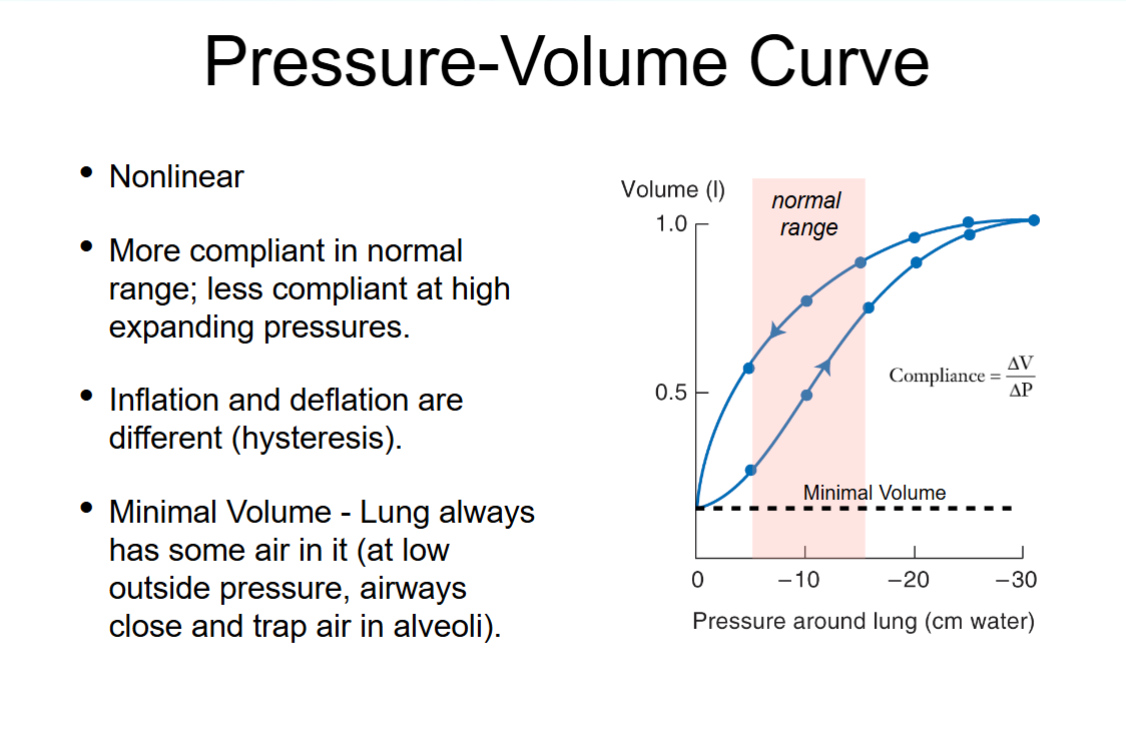
Pressure-Volume curve (Compliance differences)
Normal Normal range: lungs are very compliant (a small pressure change causes a big volume change).
High pressures: compliance decreases because the lungs are already stretched close to their limit.
Your lungs, just like the balloon, stretch the easiest in the “normal” middle range.
Pressure-Volume Curve (Hysteresis)
The inflation curve (inspiration) and deflation curve (expiration) do not overlap.
This difference is called hysteresis.
It happens because:
Surfactant reduces surface tension more effectively during deflation than during inflation.
Alveoli recruit and derecruit differently when inflating vs deflating.
Blowing up the balloon feels different than letting the air out.
When you let air out, it’s smoother and easier.
Same with lungs: inflating and deflating don’t match up perfectly.
Pressure-Volume Curve (Minimal volume)
Even when pressure outside the lungs is very low, the lungs never empty completely.
This is because airways close before all air can leave, trapping some air in the alveoli.
If you squeeze a balloon, you can usually push most of the air out — but not all of it.
Lungs are the same. They always keep a little bit of air inside, so they never go totally flat.
Lung Compliance in diseases
Emphysema
Normal
Fibrosis
Normal: Works like a normal balloon.
Emphysema: Too floppy — easy to fill, hard to empty.
Fibrosis: Too stiff — hard to fill, doesn’t hold much.
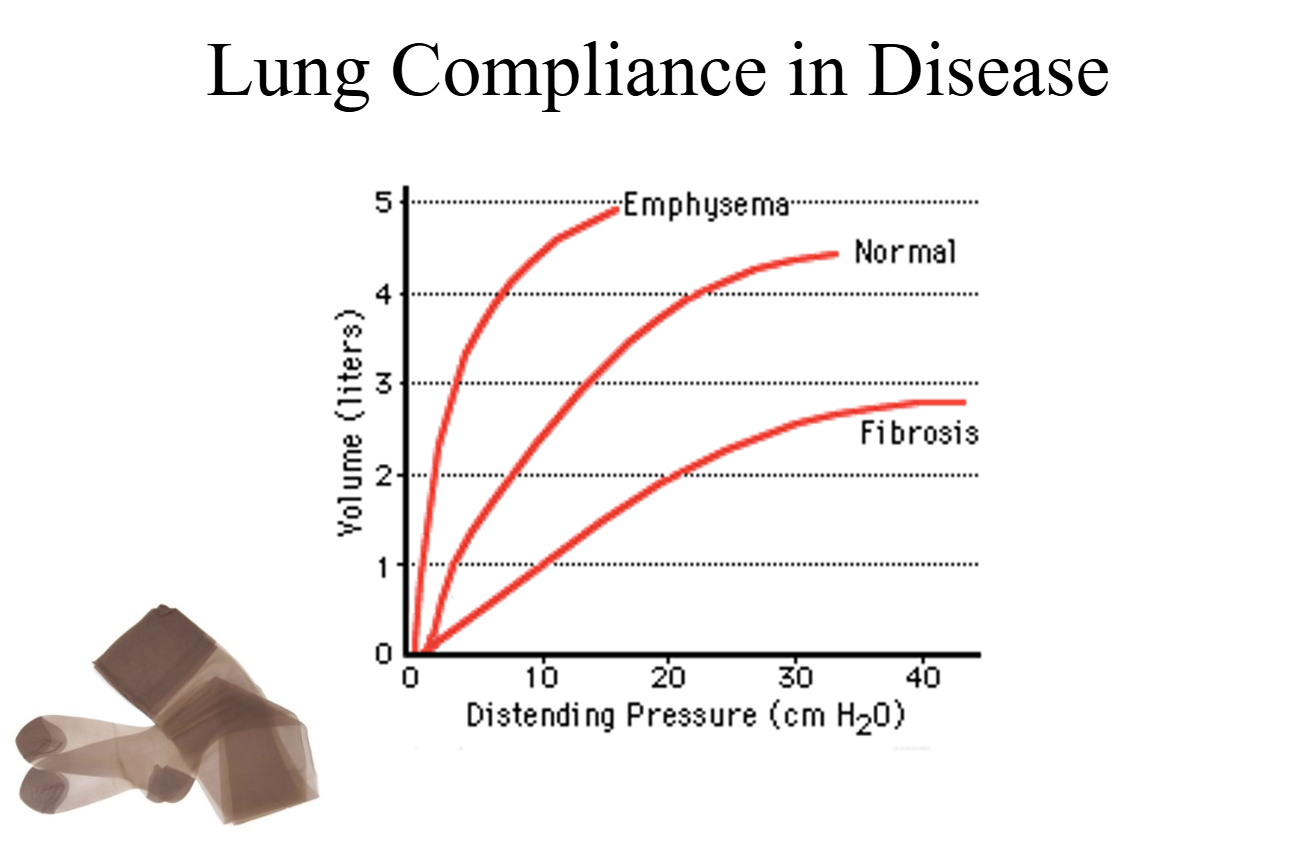
Emphysema
Too stretchy.
Like an old balloon that’s been used too many times — it stretches out really easily.
Air goes in easily (high compliance), but the problem is it doesn’t spring back well, so it’s hard to push air out.
That’s why people with emphysema have trouble exhaling.
Normal
Like a regular balloon.
Takes a little effort at first, then fills normally.
Fibrosis
Too stiff.
Like a brand-new, thick balloon that is hard to blow up.
The lungs don’t expand much, even with a lot of pressure.
That’s why people with fibrosis have trouble inhaling.
What is DPPC?
Dipalmitoyl phosphatidylcholine
-It is the key chemical in surfactant that keeps your lungs from sticking shut, like soap bubbles that don’t pop too easily
Function of surfactant
Stabilizes alveoli
Increases compliance
Prevents edma
Surfactant stabilizing alveoli
Surfactant lowers surface tension, prevents small alveoli from collapsing into bigger ones
Surfactant increasing compliance
Compliance = how easily lungs can stretch
Surfactant allows lungs to expand more easily so you don’t have to work as hard to breathe in
Surfactant Prevents edema
By reducing surface tension, surfactant decreases the pulling force that would otherwise draw fluid from blood vessels into the alveoli.
This helps keep the air sacs dry so gas exchange can happen properly.
When is surfactant produced?
Late in fetal life
What can happen if infant is not born with surfactant?
Can cause infant respiratory distress syndrome (collapsed lung)
Air inflation
Increases surface tension and decreases compliance
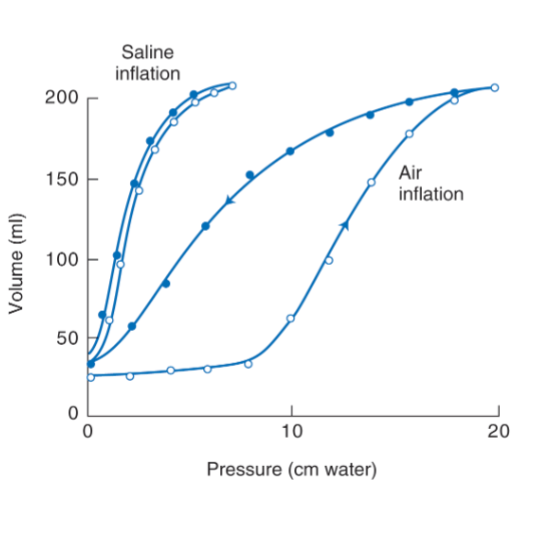
Saline inflation
Abolish surface tension and increases compliance
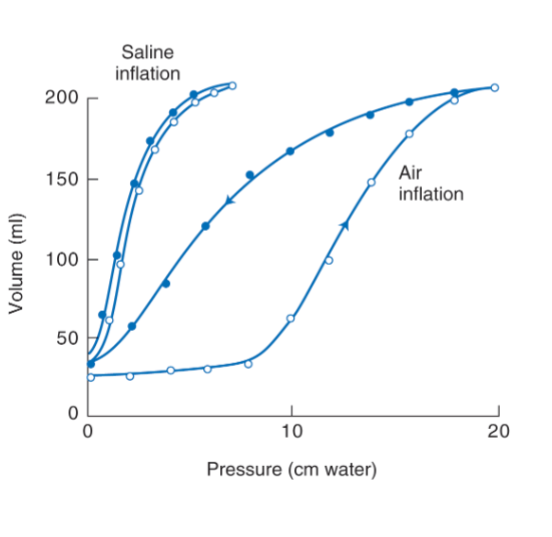
True or false
Surface tension plays a role in pressure volume relation
True
Surface tension is the main reason the lungs resist inflation. Surfactant lowers surface tension, which increases compliance, shifts the pressure–volume curve upward, and helps stabilize alveoli so they don’t collapse.
Effect on pressure-volume curve
Without surfactant:
Surface tension is very high.
It takes much more pressure to inflate the lungs (low compliance).
The P–V curve would shift downward, looking more like the fibrosis curve.
With surfactant (DPPC):
Surface tension is reduced, especially in small alveoli.
This makes it much easier to expand the lungs at normal pressures (higher compliance).
That’s why in the normal range of the pressure–volume curve, lungs are most compliant.
Normal vs pneumothorax
What is pneumothorax?
Normal: The lung stays inflated because of the gentle vacuum.
Pneumothorax: Air cancels the vacuum, the lung has nothing holding it open → it collapses.
Pneumothorax: Presence of air or gas in the cavity between the lungs and chest wall, causing collapse of the lung
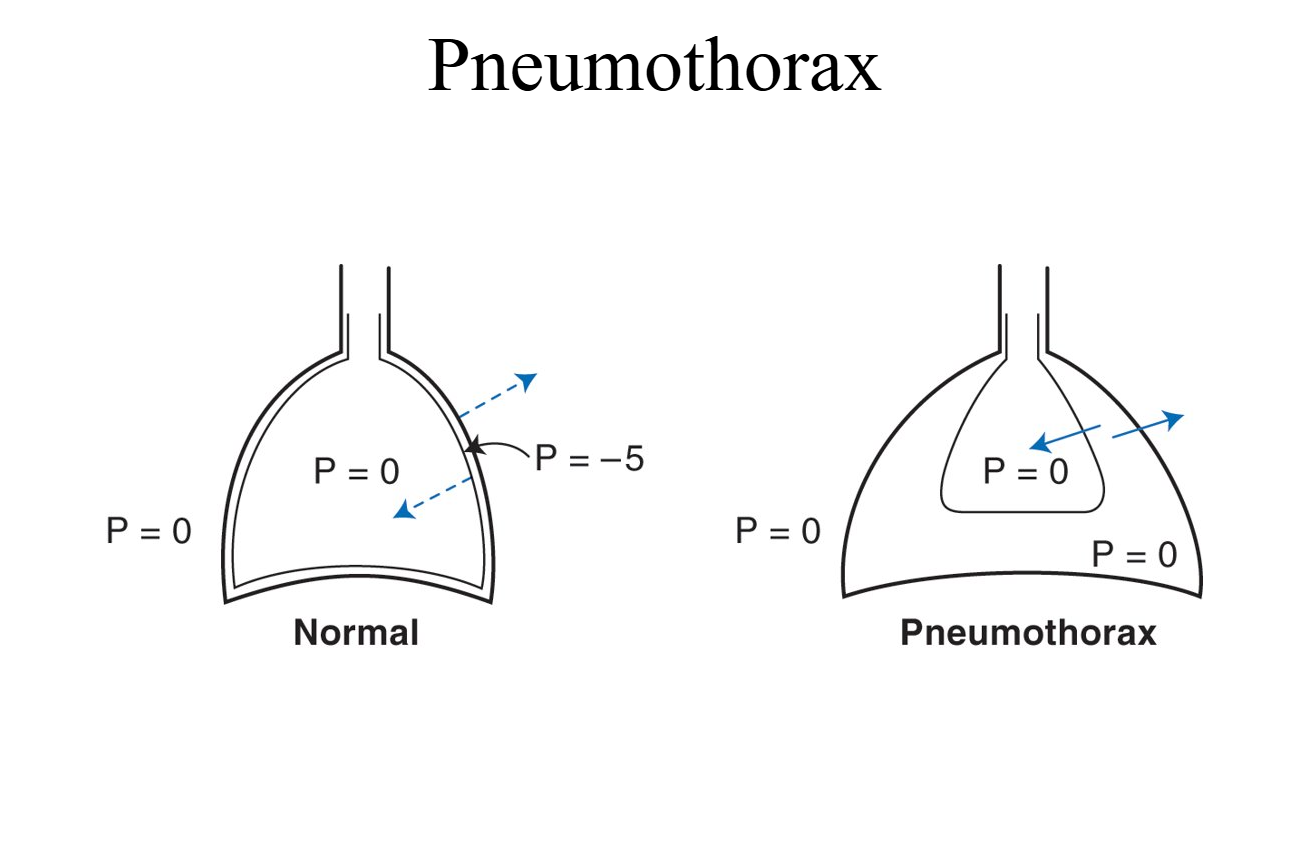
Airway resistance equation
R = 8nl/pir^4
Reducing the radius in half increases resistance by 16x
Putting both laws together gives:
So resistance increases when:
The airway gets narrower (smaller r)
The airway gets longer (l)
The air gets thicker (η)
If you cut the radius in half, resistance goes up by 16 times!
That’s because (1/2)4=1/16(1/2)^4 = 1/16(1/2)4=1/16.
So in asthma, for example, when bronchioles tighten and get smaller, airflow drops dramatically — not just a little.
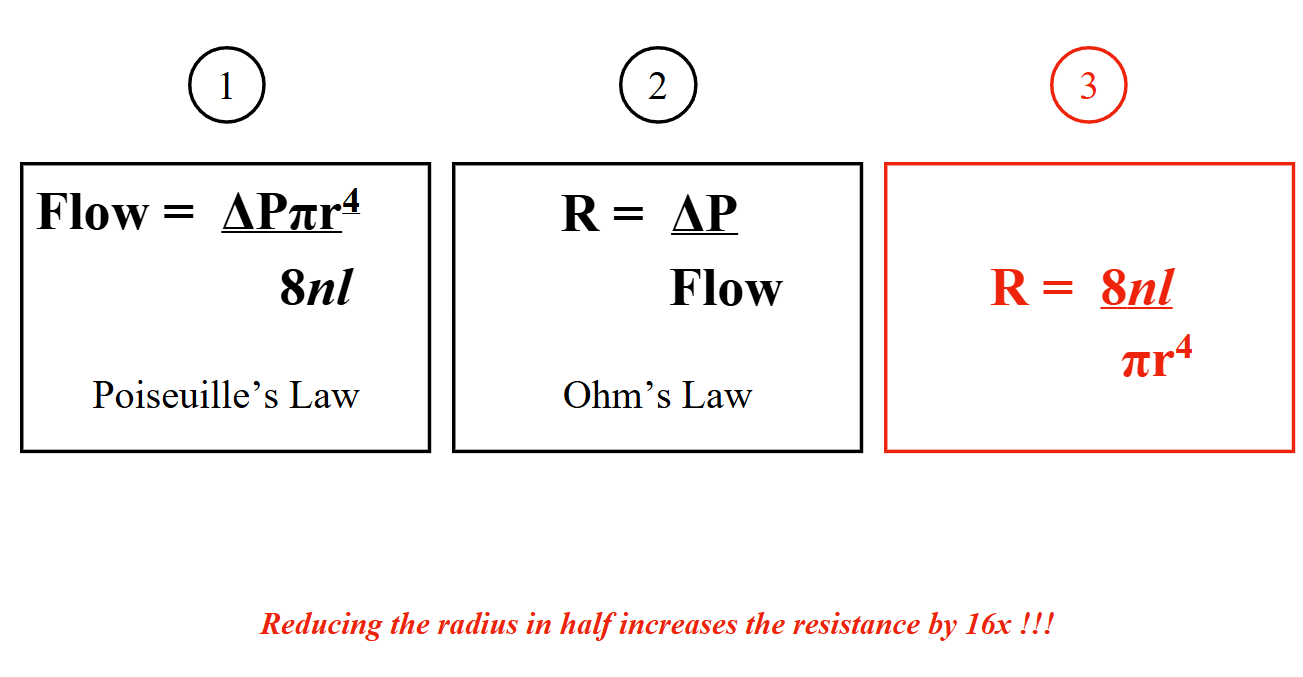
Airway resistance in different zones (where is it the highest?)
Highest at 5
-At the trachea and bronchi (large airways, early generations): resistance is fairly high.
In the medium-sized bronchi: resistance is the highest → this is where airflow faces the most difficulty.
As you move to the small bronchioles and terminal bronchioles (the tiniest branches): resistance drops a lot because there are millions of them in parallel, like a bunch of side streets taking the traffic instead of one crowded highway.
So the curve looks like a hill: starts moderate, peaks in the mid-sized bronchi, then falls way down in the small airways.
Airway resistance/Conductance and lung volume graph
At low lung volume (near empty lungs):
Airway resistance is high (airways are narrow or may even collapse).
Conductance is low (harder for air to move).
At mid lung volume:
Airways start to open wider.
Resistance goes down.
Conductance goes up.
At high lung volume (big inhale):
Airways are pulled open the most.
Resistance is at its lowest.
Conductance is at its highest.
Big takeaway:
High lung volume = wide open airways = low resistance, high conductance.
Low lung volume = narrow airways = high resistance, low conductance.
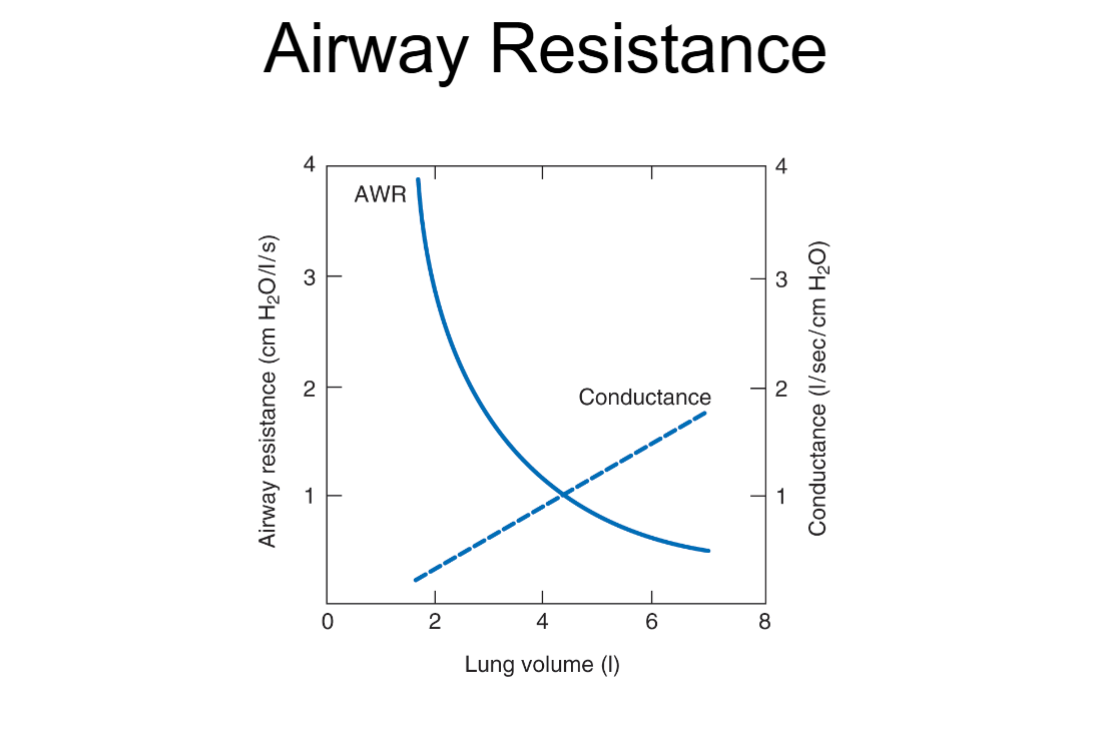
When You Inflate the Lung with Air:
Air + fluid = surface tension.
The fluid lining the alveoli creates a pulling force that makes it harder to expand the lungs.
So you need more pressure to fill the lungs with air.
This means compliance (ease of lung expansion) is lower — the lung feels stiffer.
📉 More surface tension → less compliance.
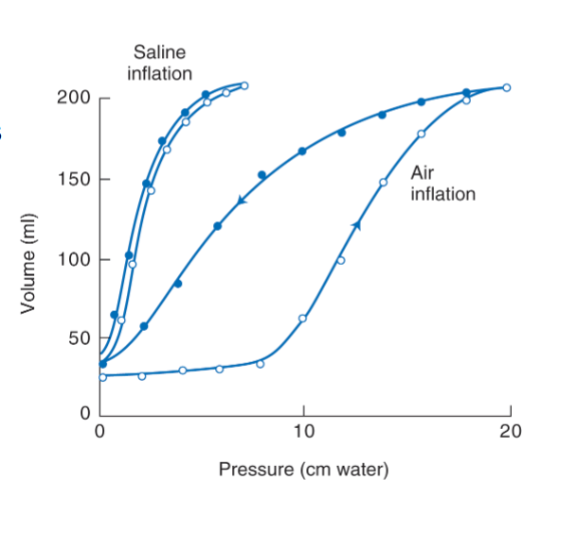
When You Inflate the Lung with Saline:
Saline replaces air, so there’s no air-fluid interface → no surface tension.
The lungs inflate much more easily, because that collapsing force is gone.
So compliance increases — it takes less pressure to get the same volume.
📈 No surface tension → higher compliance.
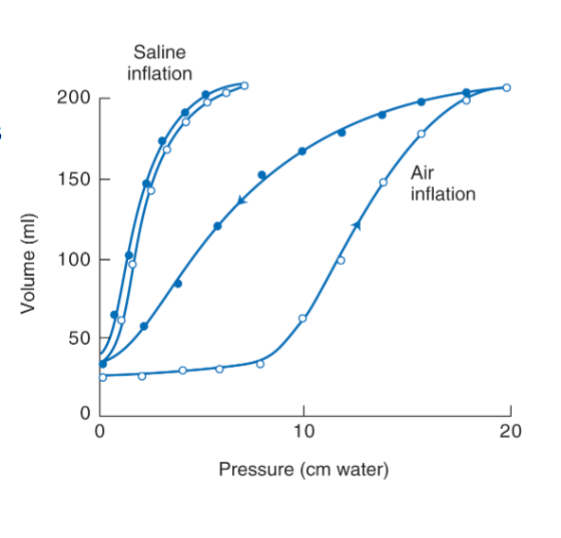
Saline vs Air inflation
In Saline inflation, the lung is much more compliant and loses its natural hysteresis compared to normal loop. (Inhalation and expiration have the same path)
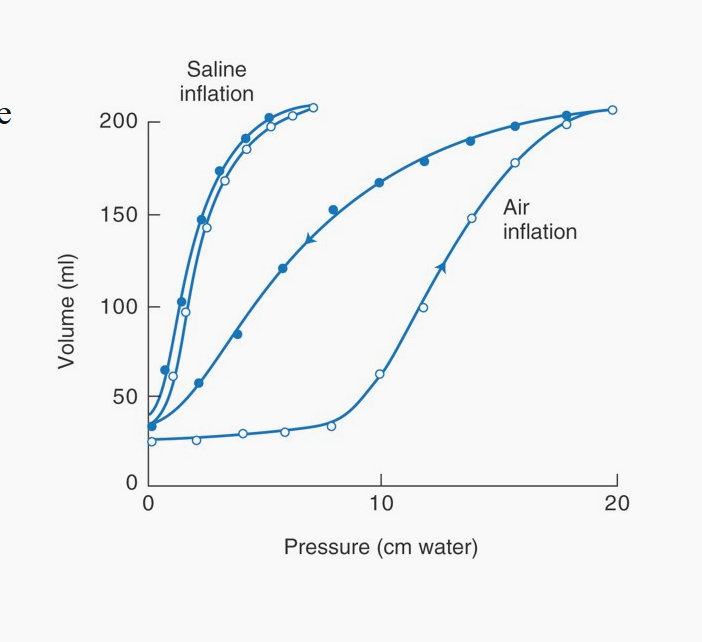
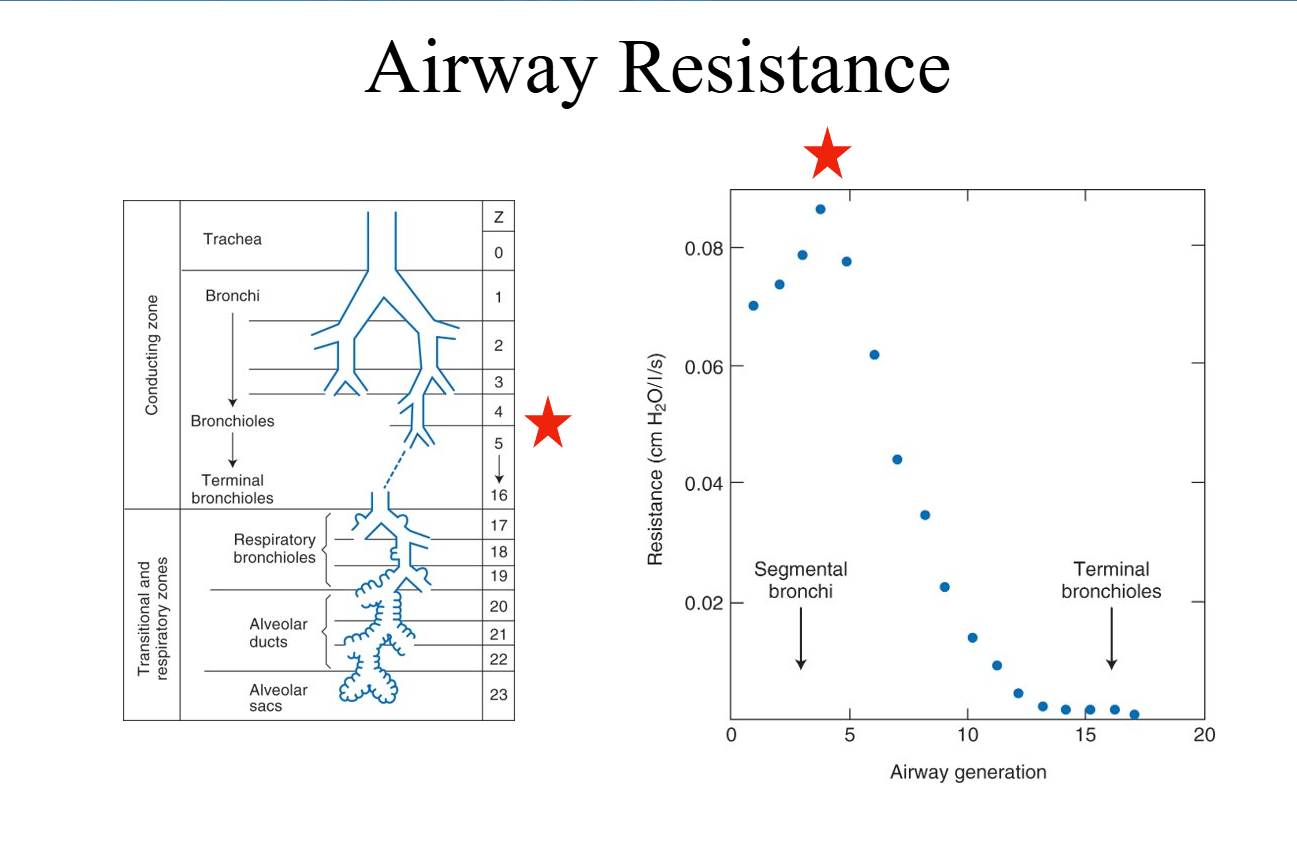
Airway Resistance Basics
Airway resistance is how hard it is for air to move through your lungs.
Think of it like friction for airflow — the smaller or fewer the tubes, the harder it is to breathe through them.
Big tubes (like the trachea) have low resistance, and the tiniest tubes (deep in the lungs) also have low resistance — but for different reasons.
Analogy:
Imagine traffic flowing down a highway:
The trachea is like a wide highway entrance (easy flow).
The bronchi are like a single toll plaza (lots of cars trying to squeeze through — high resistance).
The bronchioles are like hundreds of small side streets — the cars spread out, and traffic flows easily again.
Air way resistance and conductance
Airway Resistance (solid line)
When your lungs are small (low volume) — like at the end of a breath out — the airways are narrower because they’re not stretched open.
→ Air has a harder time moving in and out → high resistance.As you inhale and your lungs expand, the airways stretch wider.
→ Air can flow more easily → resistance drops.
✅ So, the fuller your lungs, the lower the airway resistance.
Conductance (dashed line)
Conductance is just the opposite of resistance — how easily air flows.
When lungs are small → low conductance (hard to move air).
When lungs are large → high conductance (air moves easily).
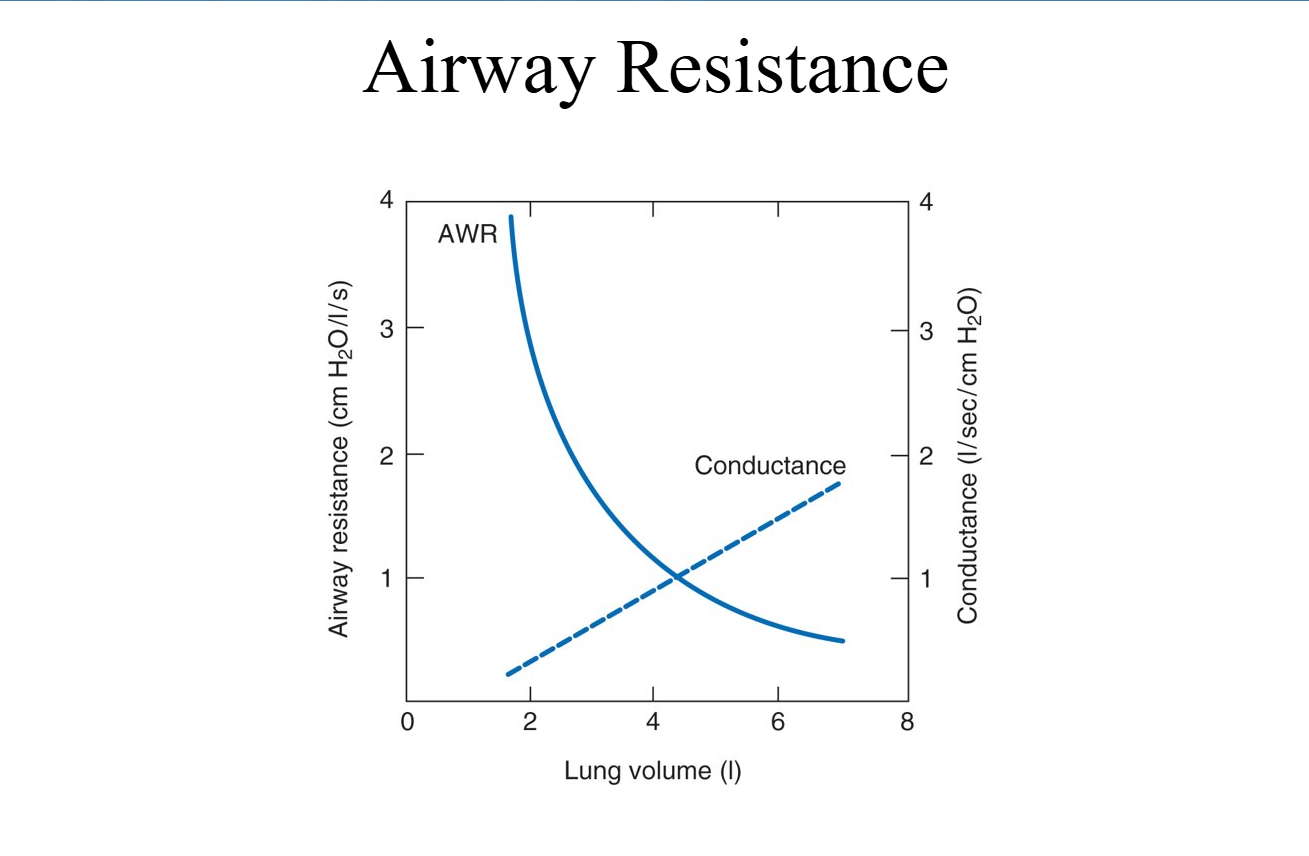
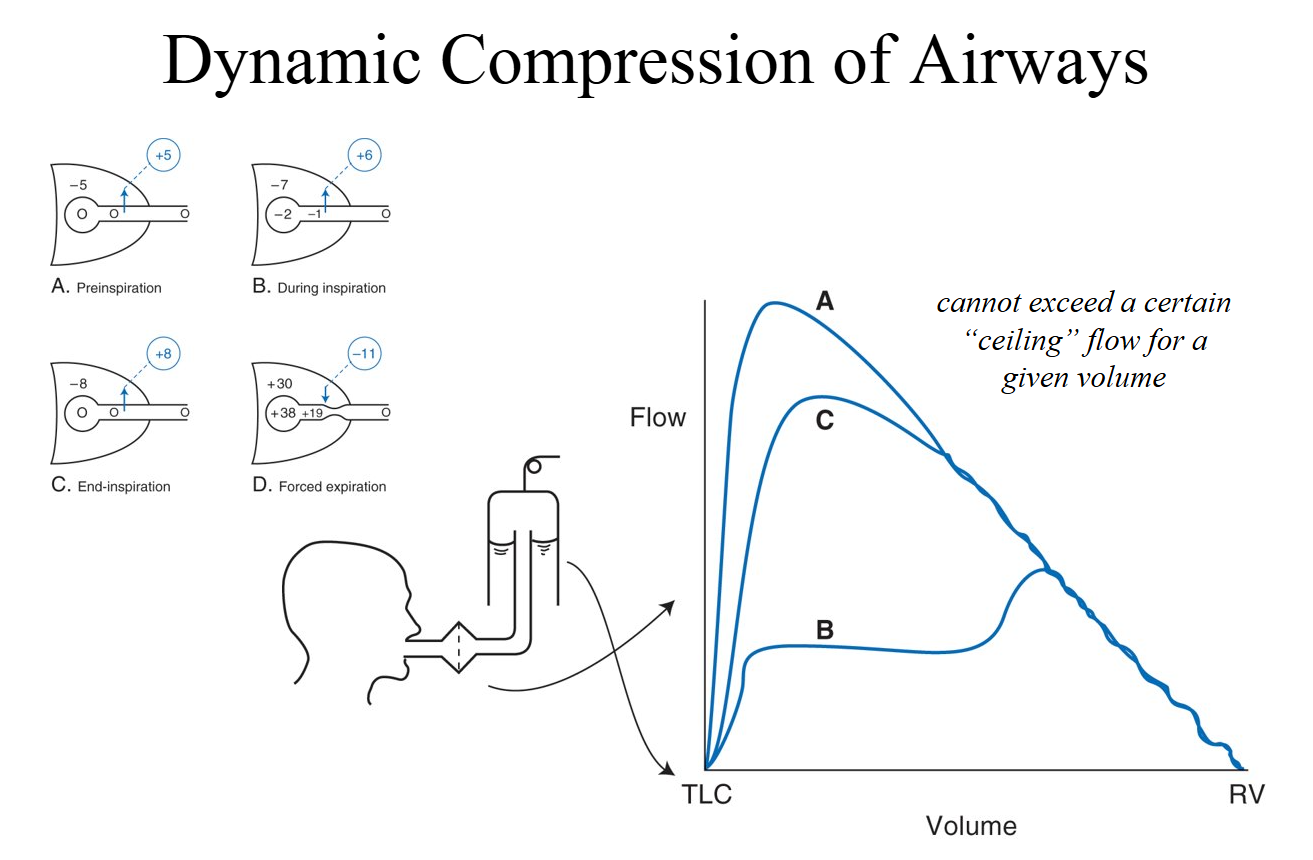
Dynamic compression of airways
📊 The Flow-Volume Graph (right side)
TLC (Total Lung Capacity) = full lungs
RV (Residual Volume) = after full exhalation
Each curve (A, B, C) represents exhaling from different starting conditions:
A = healthy person
B = someone with airway obstruction (like COPD)
C = mild obstruction or restriction
All the curves show that at some point, airflow flattens out — that’s the “flow ceiling.”
No matter how much effort you use, air can’t come out any faster because the airways collapse dynamically.
In Simple Terms:
When you blow out hard, your lungs push so much pressure on the airways that the smaller tubes get squeezed shut — like pinching a straw while blowing through it.
Once that happens, blowing harder doesn’t make air leave faster — it’s already at its max flow rate for that lung volume.
What is the equation for compliance?
Compliance = Change in volume / Change in Pressure